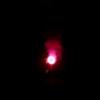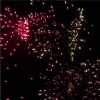Finally got round to putting up my first post on the forum!
So while I await my application for an Aquire & Keep to be processed (the Greater London ELO said he received over 100 applications after Christmas so it could be a while) I figured I needed something exciting to keep me busy which won't disturb the neighbours too much. Hence I felt some colour experimentation coming on!
Now the supply of perchlorate has basically dried up and I've got to make my left over stock last (so only using it for nice stars for special occasions), I was wondering if it was possible to make coloured stars using old fashioned potassium nitrate, of which I have plenty.
Some background to my nitrate star project:
- The reason perchlorates are used for coloured stars is because they burn at relatively high temperatures. This varies from around 2200oC when used with organic fuels and 3500oC when used with metallic fuels.
- A hot flame is required to put the metal ions which produce colour into a gaseous state in the flame, the necessary temperature has to be roughly over 2000oC although it does vary slightly between metals.
- Nitrates burn at much cooler temperatures! When used with an organic fuel the temperature is roughly 1750oC while with a metallic fuel it is around 2500oC.
- Addition of organic material or an inert metal salt (such as a carbonate) to a metallically fuelled flame reduces the temperature dramatically, this includes adding chlorine donors such as parlon and PVC.
Now to create a hot enough flame using potassium nitrate as the oxidiser is clearly going to require a metallic fuel to get the flame temperature up to a high enough temperature to achieve a colourant in the gaseous phase. The choice of metallic fuel is going to be aluminium, magnesium or magnalium. Some basic chemistry research reveals that the metal with the highest heat of combustion (the heat given off when it is combined with oxygen from its elemental form) is aluminium, so that answers that question. So we have so far:
- The stars must be metallically fuelled.
- Aluminium is the hottest metallic fuel for this purpose.
- The quantity of colourant and chlorine donor must be kept to a minimum to keep the flame heat high enough to produce colour.
So for my first test I'm going to simply try to see if I can get the composition to get hot enough to produce the basic colour from an added metal salt (without a chlorine donor). These colours vary slightly from what we usually take to be the classical colours produced by various metals. Thanks to Shimizu's book here are the colours I'm looking for:
- Calcium: Orange.
- Copper: Pale Green.
- Strontium: Orange Red.
- Barium: White.
Now to the ingredients. I have most things available to me but to make it easy for people to use the formulae, I'd like to keep it down to easily accessible chemicals. Clearly an aluminium flame is necessary so I'm thinking to base the formulae on a basic nitrate flash (relatively insensitive and burns nice and hot). To make the formulae even more insensitive and because it's easily bought from art stores, the aluminium I'm using is the atomised variety. Obviously nitrates and aluminium have the potential to react so I'm adding 2% boric acid (which annoyingly affects the flame temperature but is necessary). The metal colourants I'm going to use are all carbonates as these can be bought from pottery supply stores and they're easy to work with and relatively non-toxic.
I'm simply going to test unconfined piles of composition (I know, making them into stars changes the burning characteristics but baby steps first!) first using the following general formula, by weight, with everything except the aluminium mixed by passing through an 80 mesh screen, then the aluminium diapered in:
- Potassium Nitrate - 41%
- Sulphur - 17%
- Atomised Aluminium - 25%
- Metal Carbonate - 15%
- Boric Acid - 2%
The calcium carbonate composition burnt a bright orange colour, the copper carbonate composition burnt a bright white with tinges of very pale green at the edges, the strontium carbonate composition burnt a white with tinges of orange at the edges and lastly the barium carbonate composition burnt a bright white colour. Nitrate based flash on its own of course burns a nice white so can't really say much about the barium, but the others seem to have worked somewhat! Now to work out compositions which include some chlorine donors...
As with any good science, the key to good results is lots of repetition! So if anyone out there would like to give these a crack, then please do, and report back what colour you get (and feel free to change the formula if you need to, i.e. use flake aluminium or copper oxide instead of carbonate etc). Happy experimenting!
















